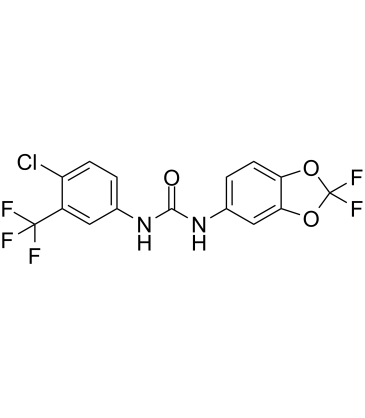| Cas No.: | 2165324-62-7 |
| Chemical Name: | PK150;PK-150;PK 150 |
| Synonyms: | PK150;PK-150;PK 150 |
| SMILES: | O=C(NC1C=C(C(F)(F)F)C(Cl)=CC=1)NC1C=C2OC(F)(F)OC2=CC=1 |
| Formula: | C15H8ClF5N2O3 |
| M.Wt: | 394.68 |
| Sotrage: | 2 years -20°C Powder, 2 weeks 4°C in DMSO, 6 months -80°C in DMSO |
| Publication: | [1]. Le P, et al. Repurposing human kinase inhibitors to create an antibiotic active against drug-resistant Staphylococcus aureus, persisters and biofilms. Nat Chem. 2019 Dec 16. |
| Description: | PK150, an analogue of Sorafenib, shows oral bioavailability and antibacterial activity against several pathogenic strains at submicromolar concentrations. PK150 inhibits Gram-positive Methicillin-sensitive S. aureus (MSSA), Methicillin-resistant S. aureus (MRSA), Vancomycin intermediate S. aureus (VISA) with MICs of 0.3, 0.3-1, 0.3 µM, respectively[1]. |
| In Vivo: | The in vivo efficacy of PK150 against methicillin-sensitive S. aureus (MSSA) (strain SH1000) is demonstrated in a murine bloodstream infection model. PK150 (20 mg/kg; p.o.) significantly reduces bacterial loads in the liver and heart[1]. PK150 (10 and 20mg/kg orally; or 10mg/kg intravenously) shows no obvious signs of toxicity in mice. Higher i.v. dosing of 20mg/kg results in severe toxic effects and is thus avoided for subsequent therapeutic models[1]. Animal Model: Pathogen-free 9-week old female C57BL/6J mice[1] Dosage: 20 mg/kg Administration: Administered p.o. Result: Bacterial loads in the liver and heart were both significantly reduced by approximately 100-fold. Animal Model: Outbred male CD-1 mice, 4 weeks old[1] Dosage: 10 and 20 mg/kg (Pharmacokinetic Analysis) Administration: Administered by intragastric gavage at 10 and 20 mg/kg or intravenously at 10 mg/kg Result: Oral bioavailability was approximately 63% and the mean residence time was slightly enhanced via this administration route. T1/2=11.69±1.5, 9.67±0.2, and 9.37±0.5 hours for 10 mg/kg i.v., 10 mg/kg p.o., and 20 mg/kg p.o., respectively. |

 To enhance service speed and avoid tariff delays, we've opened a US warehouse. All US orders ship directly from our US facility.
To enhance service speed and avoid tariff delays, we've opened a US warehouse. All US orders ship directly from our US facility.




















